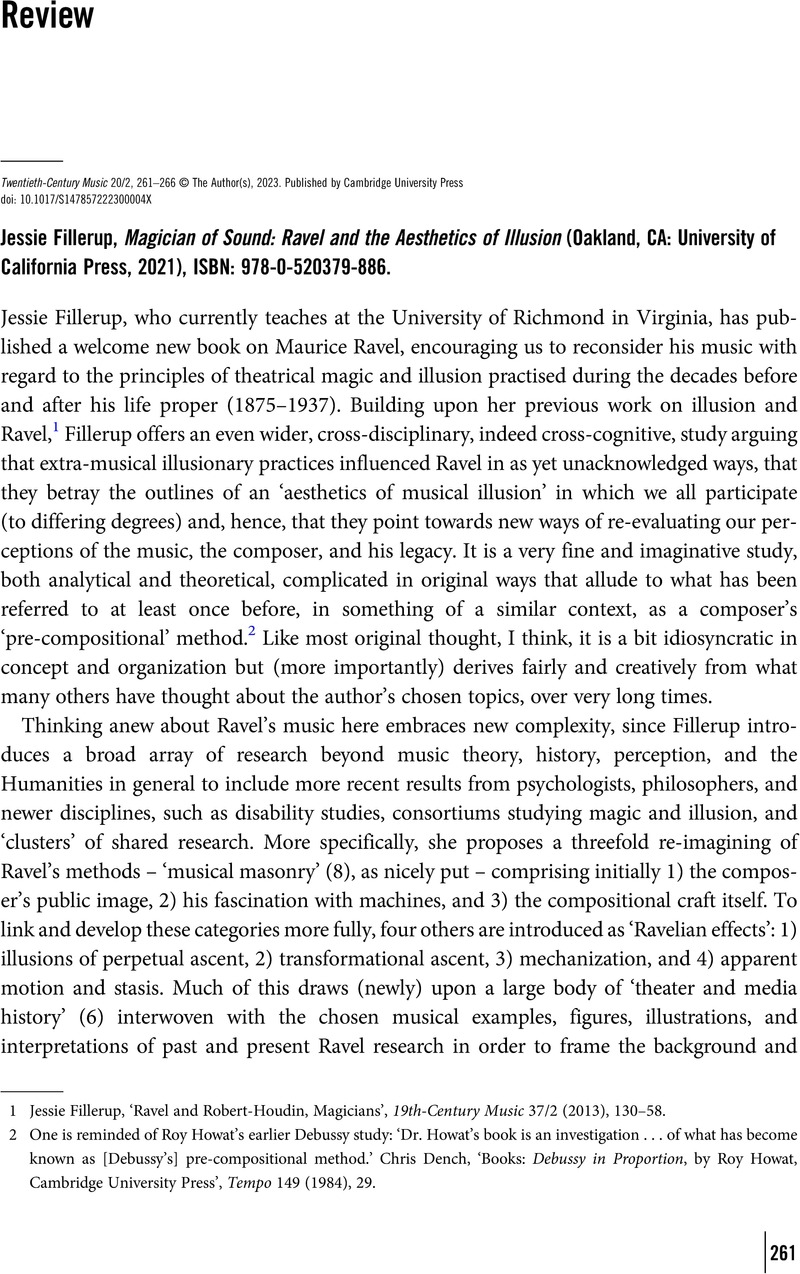No CrossRef data available.
Article contents
Jessie Fillerup, Magician of Sound: Ravel and the Aesthetics of Illusion (Oakland, CA: University of California Press, 2021), ISBN: 978-0-520379-886.
Review products
Published online by Cambridge University Press: 13 March 2023
Abstract

- Type
- Review
- Information
- Copyright
- Copyright © The Author(s), 2023. Published by Cambridge University Press
References
1 Fillerup, Jessie, ‘Ravel and Robert-Houdin, Magicians’, 19th-Century Music 37/2 (2013), 130–58CrossRefGoogle Scholar.
2 One is reminded of Roy Howat's earlier Debussy study: ‘Dr. Howat's book is an investigation … of what has become known as [Debussy's] pre-compositional method.’ Dench, Chris, ‘Books: Debussy in Proportion, by Roy Howat, Cambridge University Press’, Tempo 149 (1984), 29Google Scholar.
3 Regarding automata, ‘mechanical’ aspects of Ravel's style, reception, and much more historically, see Abbate, Carolyn, ‘Outside Ravel's Tomb’, Journal of the American Musicological Society 52/3 (1999), 465–530CrossRefGoogle Scholar. For a more economic/cultural interpretation from ‘POMO’ times, see Kramer, Lawrence, ‘Consuming the Exotic; Ravel's Daphnis and Chloé’, in Classical Music and Postmodern Knowledge (Berkeley, CA: University of California Press, 1995), 201–25CrossRefGoogle Scholar.
4 Potter, Caroline, ‘Review of Mawer, 2013’, Music & Letters 94/3 (2013), 536–38CrossRefGoogle Scholar, acknowledging Mawer's influence, which can be extended back another decade, that is, Deborah Mawer, ed., The Cambridge Companion to Ravel (Cambridge: Cambridge University Press, 2000).
5 The year, I think, should be 1907. The premiere of the Histoires naturelles was not in 1908, rather the year before. The letter has been reproduced elsewhere, including Lesure, François and Nichols, Roger, Debussy Letters, Selected and Edited by François Lesure and Roger Nichols, trans. Nichols, Roger (Cambridge, MA: Harvard University Press, 1987), 177–8Google Scholar.
6 Laloy, early and distinguished French musicologist and critic, was (uniquely, it appears) allied with both Debussy and Ravel from at least 1904. See Goubault, Christian, La Critique musicale dans la presse française de 1870–1914 (Geneva and Paris: Slatkine, 1984)Google Scholar, as confirmed later by others, that is, François Lesure and Roger Nichols.
7 Fair enough, but put a bit differently, fakir and faiseur de tours were certainly in use by those seeking to shape fin de siècle musical life in Paris (especially after the 1889 and 1899 World Exhibitions), to include (thankfully) Judith Gautier and probably others yet to be discovered; they can be found (especially fakir) in other sources (even Baudelaire), before 1900.
8 Essentially the opposite of ‘tricksterism’, a term used (allegedly) by Ravel himself in 1910 when discussing Chopin in the press, by Florent Schmitt nearly thirty years later (just after Ravel's death) concerning the Duo sonate (and others in between). Ravel, Maurice, ‘Les Polonaises, les Nocturnes, les Impromptus, la Barcarolle – Impressions’, Courrier musical 13/1 (1 January 1910), 31Google Scholar; and Florent Schmitt, ‘Une belle Exécution de la sonate pour violon et violoncelle de Maurice Ravel’, Le Temps, 8 January 1938, 3.
9 As is well known, Freud spent a year in Paris in medical residency. Among his devoted followers was the great-grandniece of the emperor, a devotee also of Poe. Eventually instrumental in Freud's escape from the Nazis, she published one of the first monographs on Poe. Like Fillerup, Peter Kaminsky concludes his volume of Ravel studies with a detailed (though Freudian oriented) essay on L'Enfant et les sortilèges. Kaminsky, Peter, ‘The Child on the Couch’, in Unmasking Ravel: New Perspectives on the Music, ed. Kaminsky, Peter (Rochester, NY: University of Rochester Press, 2011), 306–30Google Scholar.
10 As recounted with later detail by his longest surviving composition student. See pp. 77–8 in Rosenthal, Manuel and Marnat, Marcel, Ravel: Souvenirs de Manuel Rosenthal (Paris: Hazan, 1995)Google Scholar.
11 Goehr, Lydia, Elective Affinities: Musical Essays on the History of Aesthetic Theory (New York: Columbia University Press, 2008), 35Google Scholar.
12 The fundamentals have been gathered over several decades by Arbie Orenstein, Roger Nichols, Marcel Marnat, and more recently revised by Nichols in 2011. Nichols, Roger, Ravel (New Haven, CT, and London: Yale University Press, 2011), 60–4Google Scholar. Fillerup, of course, adds newly found materials for her discussion about the aesthetic consequences of mechanized warfare.
13 Orenstein, Arbie, Ravel, Man and Musician (New York: Columbia University Press, 1975; reissued 1991), 8Google Scholar.
14 Theo Hirsbrunner judged ‘Gibet’ (and Gaspard) to have been in anticipation of Messiaen. Hirsbrunner, Theo, Maurice Ravel, sein Leben, sein Werk (Laaber: Laaber Verlag, 1989), 181–3Google Scholar.
15 Or ‘agglomerations’ of (in the French sense) greater, even cultural ‘unions’.
16 It would have been helpful to find ‘Jankélévitch’ included among other of his index entries here, and especially p. 2, where a question of his about Ravel's style is cited as seminal in Fillerup's book.
17 These included Roland-Manuel, Ralph Vaughan Williams, Manuel Rosenthal, perhaps Lennox Berkeley, and a few others.
18 Zay was soon forced (as a Jew) to resign his post, fled Paris, and was eventually arrested and murdered by Nazis in Bordeaux. Benoist-Méchin, Jacques, Sixty Days That Shook the West: The Fall of France, 1940, trans. Wiles, Peter (London: Jonathan Cape, 1963), 420Google Scholar.
19 Le Temps, 31 December 1937, quoted in Orenstein, Ravel, Man and Musician, 109. The concluding pages of Nichols, Ravel, are disquieting but elegant (342–7, and the following ‘Postlude’).





